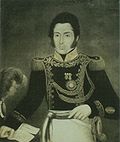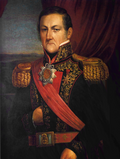|
Portrait |
Name
(Birth–Death) |
Term of office |
Elections |
Political
party
(Coalition) |
Notes |
Vice President |
|
|---|
| Start |
End |
|
 |
Bartolomé Mitre
(1821–1906) |
12 December 1861 |
12 April 1862 |
— |
Liberal |
Governor of Buenos Aires Province de facto in charge of the national government after the Battle of Pavón and the resignation of Juan Esteban Pedernera. During the following months, the provinces gave Mitre different powers.[note 1] |
Vacant |
[32] |
| 12 April 1862 |
2 June 1862 |
Appointed himself by decree as "Governor of Buenos Aires Province in charge of the National Executive Power". |
[33] |
| 2 June 1862 |
12 October 1862 |
The National Congress appointed the Governor of Buenos Aires as the person in charge of the National Executive Power until elections were held. |
[34] |
| 12 October 1862 |
12 October 1868 |
1862 |
Liberal
Nacionalist |
Indirect elections with Mitre as the only candidate. First president of the unified country. Waged the War of the Triple Alliance. |
Marcos Paz
(Died 2 January 1868)
Acting President of Argentina from 12 June 1865 until 2 January 1868. |
[35] |
| Vacant |
|
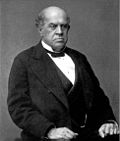 |
Domingo Faustino Sarmiento
(1811–1888) |
12 October 1868 |
12 October 1874 |
1868 |
— |
Indirect elections. Ended the War of the Triple Alliance. |
Adolfo Alsina |
[35] |
|
 |
Nicolás Avellaneda
(1837–1885) |
12 October 1874 |
12 October 1880 |
1874 |
National
↓
PAN |
Indirect elections. Federalization of Buenos Aires City in September 1880. |
Mariano Acosta |
[35] |
|
 |
Julio Argentino Roca
(1843–1914) |
12 October 1880 |
12 October 1886 |
1880 |
PAN |
Indirect elections. First term. End of the Argentine Civil Wars. |
Francisco Bernabé Madero |
[36] |
|
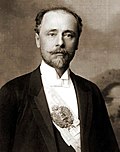 |
Miguel Ángel Juárez Celman
(1844–1909) |
12 October 1886 |
6 August 1890 |
1886 |
PAN |
Indirect elections. Resigned following the Revolution of the Park. |
Carlos Pellegrini |
[37] |
|
 |
Carlos Pellegrini
(1846–1906) |
6 August 1890 |
12 October 1892 |
PAN |
Vice President under Juárez Celman, assumed the presidency after his resignation. Finished the presidential period 1886–1892. |
Vacant |
[37] |
|
 |
Luis Sáenz Peña
(1822–1907) |
12 October 1892 |
22 January 1895 |
1892 |
PAN |
Indirect elections. Government victory in the Revolution of 1893. Resigned. |
José Evaristo Uriburu |
[38] |
|
 |
José Evaristo Uriburu
(1831–1914) |
22 January 1895 |
12 October 1898 |
PAN |
Vice President under Sáenz Peña, assumed the presidency after his resignation. Finished the presidential period 1892–1898. |
Vacant |
[38] |
|
 |
Julio Argentino Roca
(1843–1914) |
12 October 1898 |
12 October 1904 |
1898 |
PAN |
Indirect elections. Second term. |
Norberto Quirno Costa |
[39] |
|
 |
Manuel Quintana
(1835–1906) |
12 October 1904 |
12 March 1906 † |
1904 |
PAN |
Indirect elections. Government victory in the Revolution of 1905. Died in office. |
José Figueroa Alcorta |
[40] |
|
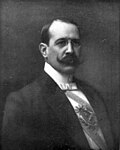 |
José Figueroa Alcorta
(1860–1931) |
25 January 1906 |
12 March 1906 |
PAN |
Vice President under Quintana. Acting president during his illness. |
Himself |
[40] |
| 12 March 1906 |
12 October 1910 |
Vice President under Quintana, assumed the presidency after his death. Finished the presidential period 1904–1910. |
Vacant |
|
 |
Roque Sáenz Peña
(1851–1914) |
12 October 1910 |
9 August 1914 † |
1910 |
PAN
Modernist |
Indirect elections. Promoted the Sáenz Peña law, which allowed secret, universal and mandatory suffrage. Died in office. |
Victorino de la Plaza |
[41] |
|
 |
Victorino de la Plaza
(1840–1919) |
9 August 1914 |
12 October 1916 |
PAN |
Vice President under Sáenz Peña, assumed the presidency after his death. Finished the presidential period 1910–1916. |
Vacant |
[41] |
|
 |
Hipólito Yrigoyen
(1852–1933) |
12 October 1916 |
12 October 1922 |
1916 |
UCR |
Free indirect elections. First president elected under the Sáenz Peña law. First term. Maintained neutrality during World War I. |
Pelagio Luna
(Died 25 June 1919) |
[42] |
| Vacant |
|
 |
Marcelo Torcuato de Alvear
(1868–1942) |
12 October 1922 |
12 October 1928 |
1922 |
UCR |
Free indirect elections. |
Elpidio González |
[42] |
|
 |
Hipólito Yrigoyen
(1852–1933) |
12 October 1928 |
6 September 1930 |
1928 |
UCR |
Free indirect elections. Second term, ousted from office by a coup d'état. |
Enrique Martínez |
[43] |
|
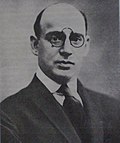 |
Enrique Martínez
(1887–1938) |
5 September 1930 |
6 September 1930 |
— |
UCR |
Vice President under Yrigoyen. Acting president during his illness. Ousted from office by a coup d'état. |
Himself |
|
|
 |
José Félix Uriburu
(1868–1932) |
6 September 1930 |
20 February 1932 |
— |
Military
(ALN) |
First coup d'état in modern Argentine history. Beginning of the Infamous Decade. Called for elections. |
Enrique Santamarina
(Resigned 20 October 1930) |
[44] |
| Vacant |
|
 |
Agustín Pedro Justo
(1876–1943) |
20 February 1932 |
20 February 1938 |
1931 |
UCR-A
(Concordancia) |
Indirect elections held with fraud and with the UCR barred from elections. |
Julio Argentino Pascual Roca |
[6]
[45] |
|
 |
Roberto Marcelino Ortiz
(1886–1942) |
20 February 1938 |
27 June 1942 |
1937 |
UCR-A
(Concordancia) |
Indirect elections held with fraud. Resigned for health reasons, died one month later. |
Ramón Castillo |
[7]
[46] |
|
 |
Ramón Castillo
(1873–1944) |
3 July 1940 |
27 June 1942 |
PDN
(Concordancia) |
Vice President under Ortiz. Acting president during his illness. |
Himself |
[7] |
| 27 June 1942 |
4 June 1943 |
Vice President under Ortiz, assumed the presidency after his resignation. Deposed in a coup d'état. End of the Infamous Decade. |
Vacant |
|
 |
Arturo Rawson
(1885–1952) |
4 June 1943 |
7 June 1943 |
— |
Military
(GOU–affiliated) |
Coup d'état. Beginning of the Revolution of '43. Ousted from office. |
[47]
[7] |
|
 |
Pedro Pablo Ramírez
(1884–1962) |
7 June 1943 |
9 March 1944 |
— |
Military
(GOU–affiliated) |
Coup d'état. On 25 February 1944, Ramírez temporarily delegated powers to Edelmiro Farrell. Resigned. |
Sabá Sueyro
(Died 15 October 1943) |
[7] |
| Edelmiro Julián Farrell |
|
 |
Edelmiro Julián Farrell
(1887–1980) |
25 February 1944 |
9 March 1944 |
— |
Military
(GOU–affiliated) |
Vice President under Ramírez. Acting president. |
Himself |
[7] |
| 9 March 1944 |
4 June 1946 |
Declared war on the Axis powers. Called for elections. End of the Revolution of '43. |
Vacant |
Juan Perón
(8 July 1944–10 October 1945) |
| Juan Pistarini |
|
 |
Juan Perón
(1895–1974) |
4 June 1946 |
4 June 1952 |
1946 |
Labour
(UCR-JR)
(Independent Party) |
Free indirect elections. First term. Reelection enabled by the Constitution of 1949. |
Hortensio Quijano
(Died 3 April 1952) |
[48] |
| Vacant |
| 4 June 1952 |
21 September 1955 |
1951 |
Peronist |
Free direct elections. Second term. First election to allow women's suffrage. Victory with 62.49% of votes, highest victory in Argentine elections. Ousted from office by a coup d'état. |
Alberto Teisaire
(7 May 1954–16 September 1955) |
| Vacant |
|
 |
Eduardo Lonardi
(1896–1956) |
16 September 1955 |
23 September 1955 |
— |
Military |
Coup d'état. Beginning of the Revolución Libertadora. By decree appointed himself as "Provisional President of the Nation"; from 19 September 1955 until 23 September 1955, the office was disputed with José Domingo Molina Gómez, the leader of the military junta. |
[49] |
| 23 September 1955 |
13 November 1955 |
Lonardi is sworn in as president. Ousted from office. |
Isaac Rojas |
|
 |
Pedro Eugenio Aramburu
(1903–1970) |
13 November 1955 |
1 May 1958 |
— |
Military |
Coup d'état. The 1949 Constitution is repealed and the 1853 Constitution is restored. End of the Revolución Libertadora. Called for elections with Peronism barred from elections. |
[49] |
|
 |
Arturo Frondizi
(1908–1995) |
1 May 1958 |
29 March 1962 |
1958 |
UCRI |
Indirect elections with Peronism barred from elections. Ousted from office by a coup d'état. |
Alejandro Gómez
(Resigned 18 November 1958) |
[50] |
| Vacant |
|
 |
José María Guido
(1910–1975) |
29 March 1962 |
12 October 1963 |
— |
UCRI |
Provisional President of the Senate exercising the Executive Power, as the civil procedures to replace the deposed president were followed and Vice President Alejandro Gómez had resigned in 1958. |
[51]
[50] |
|
 |
Arturo Umberto Illia
(1900–1983) |
12 October 1963 |
28 June 1966 |
1963 |
UCRP |
Indirect elections with Peronism barred from elections. Ousted from office by a coup d'état. |
Carlos Humberto Perette |
[52] |
|
 |
Junta of Commanders of the Armed Forces |
28 June 1966 |
29 June 1966 |
— |
Military |
|
Vacant |
|
|
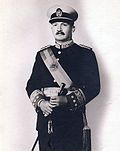 |
Juan Carlos Onganía
(1914–1995) |
29 June 1966 |
8 June 1970 |
— |
Military |
Coup d'état. Ousted from office. |
[52] |
|
|
Junta of Commanders of the Armed Forces |
8 June 1970 |
18 June 1970 |
— |
Military |
Coup d'état. Members of the Junta:
|
|
|
 |
Roberto Marcelo Levingston
(1920–2015) |
18 June 1970 |
23 March 1971 |
— |
Military |
Appointed by the Military Junta. Ousted from office. |
[52] |
|
|
Junta of Commanders of the Armed Forces |
23 March 1971 |
26 March 1971 |
— |
Military |
Coup d'état Members of the Junta:
|
|
|
 |
Alejandro Agustín Lanusse
(1918–1996) |
26 March 1971 |
25 May 1973 |
— |
Military |
Appointed by the Military Junta. End of the Argentine Revolution. Called for elections. Peronism ban lifted. |
|
|
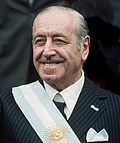 |
Héctor José Cámpora
(1909–1980) |
25 May 1973 |
13 July 1973 |
March
1973 |
PJ
(FREJULI) |
Free direct elections. Because no candidate was able to get 50% of the votes needed to win, a runoff should have taken place between Cámpora and Ricardo Balbín, but Balbín decided to withdraw his candidacy, making Cámpora president. First Peronist president after the ban. Cámpora annulled the ban that remained specifically over Juan Perón, and resigned along with his vice president. |
Vicente Solano Lima |
[53] |
|
 |
Raúl Alberto Lastiri
(1915–1978) |
13 July 1973 |
12 October 1973 |
— |
PJ
(FREJULI) |
President of the Chamber of Deputies exercising the Executive Power. Alejandro Díaz Bialet, President of the Senate and ahead of Lastiri in the succession line, was on a diplomatic mission in Africa at that time. |
Vacant |
[54]
[53] |
|
 |
Juan Perón
(1895–1974) |
12 October 1973 |
1 July 1974 † |
Sept.
1973 |
PJ
(FREJULI) |
Free direct elections. Third term. Died in office. |
Isabel Perón |
[53] |
|
 |
Isabel Perón
(born 1931) |
29 June 1974 |
1 July 1974 |
PJ
(FREJULI) |
First Lady and Vice President under Juan Perón. Acting president during his illness. |
Herself |
[55] |
| 1 July 1974 |
24 March 1976 |
Vice President of Juan Perón, assumed the presidency after his death. First female president in the Americas. From 13 September 1975 until 16 October 1975, Provisional President of the Senate Ítalo Argentino Luder exercised the Executive Power, due to the health problems of the president. She got ousted from office by a coup d'état. |
Vacant |
|
 |
Military Junta |
24 March 1976 |
29 March 1976 |
— |
Military |
|
|
|
 |
Jorge Rafael Videla
(1925–2013) |
29 March 1976 |
29 March 1981 |
— |
Military |
Coup d'état. President of the Military Junta. Longest government of a de facto ruler. |
[56] |
|
 |
Roberto Eduardo Viola
(1924–1994) |
29 March 1981 |
11 December 1981 |
— |
Military |
Appointed by Videla as President of the Military Junta. Powers and duties suspended on 21 November 1981 due to health problems. Ousted from office. |
[56] |
|
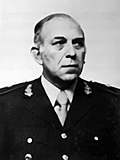 |
Horacio Tomás Liendo
(1924–2007) |
21 November 1981 |
11 December 1981 |
— |
Military |
Appointed by the Military Junta. Acting president during Viola suspension. |
|
|
 |
Carlos Lacoste
(1929–2004) |
11 December 1981 |
22 December 1981 |
— |
Military |
Appointed by the Military Junta. Interim. |
|
|
 |
Leopoldo Galtieri
(1926–2003) |
22 December 1981 |
18 June 1982 |
— |
Military |
Appointed by the Military Junta. Waged the Falklands War. Ousted from office. |
[56] |
|
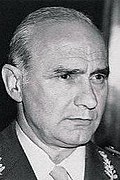 |
Alfredo Oscar Saint Jean
(1926–1987) |
18 June 1982 |
1 July 1982 |
— |
Military |
Appointed by the Military Junta. Interim. |
|
|
 |
Reynaldo Bignone
(1928–2018) |
1 July 1982 |
10 December 1983 |
— |
Military |
Appointed by the Military Junta. End of the National Reorganization Process. Called for elections. |
[56] |
|
 |
(Presidency)
Raúl Alfonsín
(1927–2009) |
10 December 1983 |
8 July 1989 |
1983 |
UCR |
Free indirect elections. The 1989 presidential elections were anticipated. Resigned during the transition and gave power to Carlos Menem six months in advance. |
Víctor Hipólito Martínez |
[57] |
|
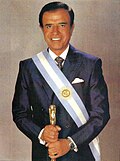 |
(Presidency)
Carlos Menem
(1930–2021) |
8 July 1989 |
8 July 1995 |
1989 |
PJ
(FREJUPO) |
Free indirect elections. First term. The 1994 amendment reduced the presidential term from 6 to 4 years and allowed a single consecutive reelection. |
Eduardo Duhalde
(Resigned 10 December 1991) |
[58] |
| Vacant |
| 8 July 1995 |
10 December 1999 |
1995 |
PJ
(UCeDe) |
Free direct elections. Second term. His term was extended to 10 December 1999 according to the Tenth Temporary Provision of the Constitution of 1994. |
Carlos Ruckauf |
|
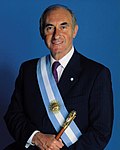 |
(Presidency)
Fernando de la Rúa
(1937–2019) |
10 December 1999 |
21 December 2001 |
1999 |
UCR
(Alianza) |
Free direct elections. Faced a severe economic crisis. Resigned after the December 2001 riots. Because his Vice President Carlos Álvarez had resigned in October 2000, the Congress Assembled selected a new president. |
Carlos Álvarez
(Resigned 6 October 2000) |
[59] |
| Vacant |
|
 |
Ramón Puerta
(born 1951) |
21 December 2001 |
23 December 2001 |
— |
PJ |
Provisional President of the Senate exercising the Executive Power. |
[60] |
|
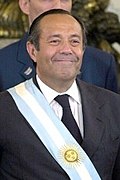 |
Adolfo Rodríguez Saá
(born 1947) |
23 December 2001 |
30 December 2001 |
— |
PJ |
Elected by the Congress for three months, with instructions to call for elections. Resigned. |
[61] |
|
 |
Eduardo Camaño
(born 1946) |
30 December 2001 |
2 January 2002 |
— |
PJ |
President of the Chamber of Deputies exercising the Executive Power. |
[62] |
|
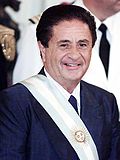 |
Eduardo Duhalde
(born 1941) |
2 January 2002 |
25 May 2003 |
— |
PJ |
Elected by the Congress, with instructions to complete De la Rúa's term. Called early elections for 27 April 2003. |
[61] |
|
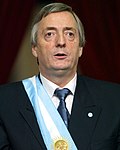 |
(Presidency)
Néstor Kirchner
(1950–2010) |
25 May 2003 |
10 December 2007 |
2003 |
PJ
(FPV) |
Free direct elections. Initially completed the remaining months of De la Rúa's term until 10 December 2003 then began his own mandate. Kirchner finished second to Carlos Menem in the first round and because no one was able to get 45% of the votes needed to win, a runoff should have taken place, but Menem decided to withdraw his candidacy, making Kirchner president. |
Daniel Scioli |
[63] |
|
 |
(Presidency)
Cristina Fernández de Kirchner
(born 1953) |
10 December 2007 |
10 December 2011 |
2007 |
PJ
(FPV) |
Free direct elections. First term. First elected female president of Argentina. |
Julio Cobos |
[64] |
| 10 December 2011 |
10 December 2015 |
2011 |
PJ
(FPV) |
Free direct elections. Second term. By judicial ruling, her mandate ended 9 December 2015 at midnight. |
Amado Boudou |
[65] |
|
 |
Federico Pinedo
(born 1955) |
10 December 2015 |
— |
PRO
(Cambiemos) |
Provisional President of the Senate exercising the Executive Power. Acting president from 00:00 hs. until Macri's swearing in at 11:45 hs. |
Vacant |
[65] |
|
 |
(Presidency)
Mauricio Macri
(born 1959) |
10 December 2015 |
10 December 2019 |
2015 |
PRO
(Cambiemos) |
Free direct elections. First president elected in a ballotage, defeating Daniel Scioli. Although his mandate begun on 10 December 2015 at 00:00 hs., it was only after he swore in the Congress at 11:45 hs. that he took office as president. |
Gabriela Michetti |
[65] |
|
 |
(Presidency)
Alberto Fernández
(born 1959) |
10 December 2019 |
10 December 2023 |
2019 |
PJ
(FdT) |
Free direct elections. |
Cristina Fernández de Kirchner |
|
|
 |
(Presidency)
Javier Milei
(born 1970) |
10 December 2023 |
Incumbent |
2023 |
PL
(LLA) |
Free direct elections.
First libertarian head of state in the world. |
Victoria Villarruel |
|


























